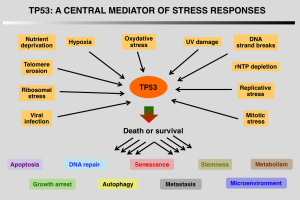Tumor Protein 53
Tumor protein 53 (TP53) is a regulatory protein that helps regulate the progression through the cell cycle, apoptosis (cell death), and the stability of the genome. It does this through a few different ways:
-
When noticing DNA damage, it activates DNA repair proteins. This is important in a lot of functions to do with aging.
-
It can stop the cell cycle when DNA damage occurs, which allows DNA repair proteins to fix the damage, then will stimulate the cell to continue through its growth cycle.
-
It will initiate apoptosis when DNA damage is irreparable

TP53 is often regarded as the ‘guardian of the genome‘ for it’s role in preventing mutations and conserving stability. Specifically in vertebrates (like humans) this protein prevents cancer formation.
How Does It Work?
TP53 acts a cellular distress sensor, normally kept at low levels. TP53 is activated when there is cellular stress such as DNA damage (caused by UV or IR radiation, or chemical agents), or oxidative stress. This activation causes 2 major things:
-
The half-life of TP53 is greatly increased, which leads to a quick accumulation in stressed cells
-
TP53 undergoes a structural change that allows it to act as a transcription regulator in the stressed cells
 The transcription regulating characteristic of activated TP53 allows it to convert DNA to RNA, which will go on to create cellular responses to the stress that is happening. To link it to TP53s main ways of regulating cells, the RNA can code for DNA repair proteins, or proteins that will initiate apoptosis if the cell damage is irreparable.
The transcription regulating characteristic of activated TP53 allows it to convert DNA to RNA, which will go on to create cellular responses to the stress that is happening. To link it to TP53s main ways of regulating cells, the RNA can code for DNA repair proteins, or proteins that will initiate apoptosis if the cell damage is irreparable.
Role in Cancer
 TP53 is mutated or deleted from the genome in over 50% of all human tumors. When the TP53 gene is damaged tumor suppression is compromised, are people with this are likely to develop tumors in early adulthood. Well maybe increasing levels of TP53 can be a good solution to preventing tumors or the spread of tumors. While this has been researched, this can cause early aging in a person, which is something that not a lot of people are too keen about. However research has been done in aiding to restore functionality of already existing TP53 in order to treat cancer. In 2003 a gene therapy called Gendicine was approved in China for the treatment of head and neck squamous cell carcinoma caner.
TP53 is mutated or deleted from the genome in over 50% of all human tumors. When the TP53 gene is damaged tumor suppression is compromised, are people with this are likely to develop tumors in early adulthood. Well maybe increasing levels of TP53 can be a good solution to preventing tumors or the spread of tumors. While this has been researched, this can cause early aging in a person, which is something that not a lot of people are too keen about. However research has been done in aiding to restore functionality of already existing TP53 in order to treat cancer. In 2003 a gene therapy called Gendicine was approved in China for the treatment of head and neck squamous cell carcinoma caner.
